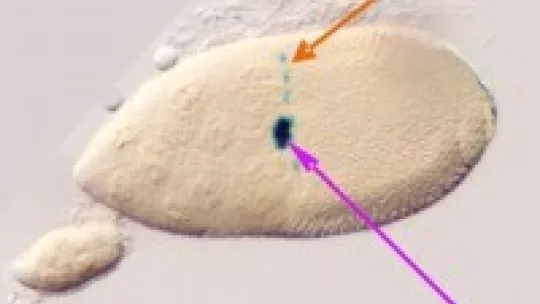Images
Research conducted by investigators from IRB Barcelona appears this week in Proceedings of the National Academy of Sciences PNAS.
Investigators from the Institute of Research in Biomedicine (IRB Barcelona) have identified a new signalling mechanism among cells in the fruit fly, Drosophila melanogaster. The researchers found that two independent groups of cells generate the same signal by different pathways and that these cells subsequently act together to send the signal to the target cell. In this manner, the receptor cell receives the signal from two distinct sources. The results of this study appear in this week advanced electronic issue of the journal PNAS.
Jordi Casanova (IRB Barcelona/CSIC) explains that different types of cells working together to send a message can be regarded as a “security measure designed to ensure that the signal reaches the receptor cell in the proper fashion, neither too weakly nor too strongly”. Using RNA interference techniques (RNAi), the researchers observed that it was necessary to disactivate the signal in both groups of cells in order to prevent the message from being sent. They also observed that overstimulating signal production (producing more of the signalling molecule) created problems in the receptor cell, causing it to develop incorrectly.
Researchers made the discovery by studying the behaviour of a gene called torso-like during the early stages of embryonic development of the Drosophila fly. Two groups of cells activated the same torso-like gene separately and by different mechanisms when they were still in separate compartments inside the Drosophila ovary. Subsequently, the cells migrated until they met and jointly signalled the target cell.
Marc Furriols, lead author of the study, explains that the torso-like gene activates a membrane receptor molecule that is specific to Drosophila, but that the molecule belongs to a receptor family (that includes, for example, the human growth factor), which also reacts when it receives an external signal. “This research describes a very signalling mechanism in the fly which is very basic. It gives us good insight into how these mechanisms work so that we can later manipulate and control them.
Many of these pathways and signalling systems have been observed throughout evolution and hence, studies with models such as the fruit fly, can provide further insight into how these signalling mechanisms work in humans.
Reference article:
Two distinct but convergent groups of cells trigger Torso receptor tyrosine Kinase activation by independently expressing torso-like
Marc Furriols, Gemma Ventura, and Jordi Casanova
PNAS epub ahead June 25-29 , 2007
About IRB Barcelona
The Institute for Research in Biomedicine (IRB Barcelona) pursues a society free of disease. To this end, it conducts multidisciplinary research of excellence to cure cancer and other diseases linked to ageing. It establishes technology transfer agreements with the pharmaceutical industry and major hospitals to bring research results closer to society, and organises a range of science outreach activities to engage the public in an open dialogue. IRB Barcelona is an international centre that hosts 400 researchers and more than 30 nationalities. Recognised as a Severo Ochoa Centre of Excellence since 2011, IRB Barcelona is a CERCA centre and member of the Barcelona Institute of Science and Technology (BIST).





